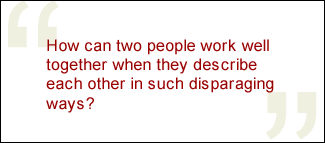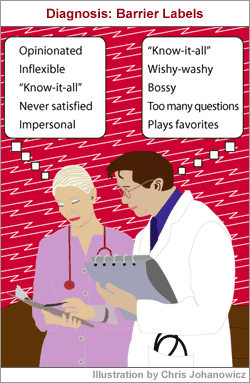In considering the relationship between two colleagues, let's use the analogy of an intersection. When we approach an intersection that's clogged with traffic, we can't pass through. The same is true for the intersection between two people. If it's blocked by a tangle of negative labels and unflattering perceptions, then effective communication is severely impaired.
 |
How can managers eliminate the use of negative labels among employees in their workgroups and improve the flow of communication? I recently tackled this question with an executive group. We were discussing the Clifton StrengthsFinder, an online assessment that measures a person's 34 themes of talent and reveals his or her top five -- or Signature -- themes.
As I was talking about some of the theme names, such as Achiever, Competition, and Empathy, one executive raised his hand and said, "I'm not so sure it's a good idea to be labeling people." My response was, "I bet a lot of labeling already occurs in your organization. And I bet it's not the positive labeling we are describing here." He chuckled and commented, "Sad, but true."
Managers know that labels can be good or bad. I call the bad ones "barrier labels." These negative terms are used when an innate talent is devalued or dismissed as a weakness. A barrier label, left unquestioned, can prevent managers from discovering employees' talents and building on them to create strengths. But when managers learn to recognize barrier labels, they can do more than avoid using those terms -- they can use them as clues to understanding an employee's talents.
 |
Doctor versus nurse
Let me give you an example. The first illustration shows how two colleagues, a doctor and a nurse, had described each other. They were clearly using barrier labels: The nurse called the doctor "inflexible," for example, while the doctor called the nurse "bossy."
Not only did these barrier labels hinder their communication, they also had a negative impact on their levels of engagement. How could these two people work together productively when they described each other in such disparaging ways?
Let's see what happened after their supervisor asked them to learn about their Signature Themes. The terms below describe the doctor's and the nurse's Signature Themes. They realized they both were exceptionally talented in the Self-Assurance theme. They also learned that their talents in Focus and Adaptability are quite different -- but also quite complementary -- when applied effectively.
The doctor and the nurse dug deeper than the initial barrier labels they had placed on one another, and they began to understand the talents that had been hindered by those negative perceptions and words. The second illustration shows how much more potential there is for communication, a stronger working relationship, and higher levels of engagement when these positive terms are used.
I've used this example many times to explain the concept of barrier labels and the ways in which they block effective communication. Recently, while I was conducting a session on this topic, one employee looked at another and said, "Now I know why you act that way! You really aren't doing it just to drive me crazy!" The two went on to have an incredibly positive discussion. The lines of communication were suddenly wide open.
 |
It's important to point out that in the case of the doctor and the nurse, their newfound mutual understanding didn't mean that the doctor was going to stop being "opinionated" or that the nurse would cease to be "bossy." Now that they had a positive way to describe those character traits, however, both the doctor and the nurse could recognize the value of those natural patterns of thought, feeling, and behavior and use them productively.
In fact, once the doctor understood the talents within his Self-Assurance theme, he could use them more effectively to help others see him as decisive instead of opinionated. The nurse also succeeded in helping her coworkers understand that what could be seen as "bossiness" is actually a manifestation of her Command talents.
By gaining a deeper understanding of their greatest talents, the doctor and the nurse became more sophisticated in their approaches to using them. They also began to interact more positively with each other based on this understanding.
Managers have a big role to play in situations like these. A strengths-development approach can help managers learn more about the powerful talents of their employees. So if a manager has a "bossy" employee -- like the nurse -- she can understand that the employee is perhaps driven by Command talents. She can also help that person tap those talents more effectively. In fact, a good manager might even help that employee go from being seen as "bossy" to being seen as a future leader of the organization.
If managers understand the talents that lie behind the barrier labels that are placed on their employees, they can change the dynamics of workplace relationships for the better. They can clear up the "traffic jams" that block workgroups from reaching their full productive potential.